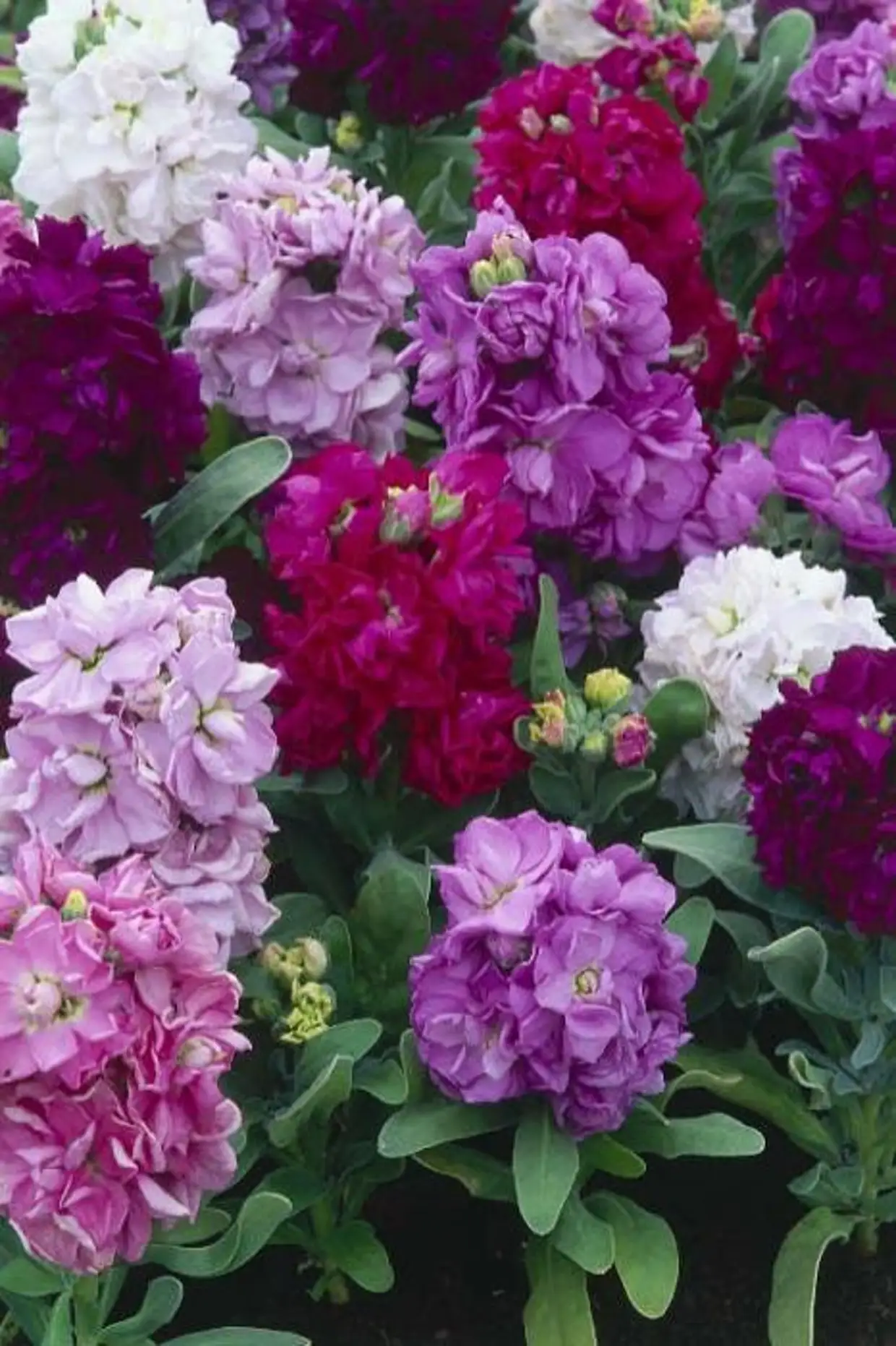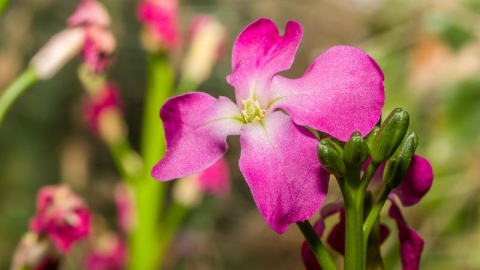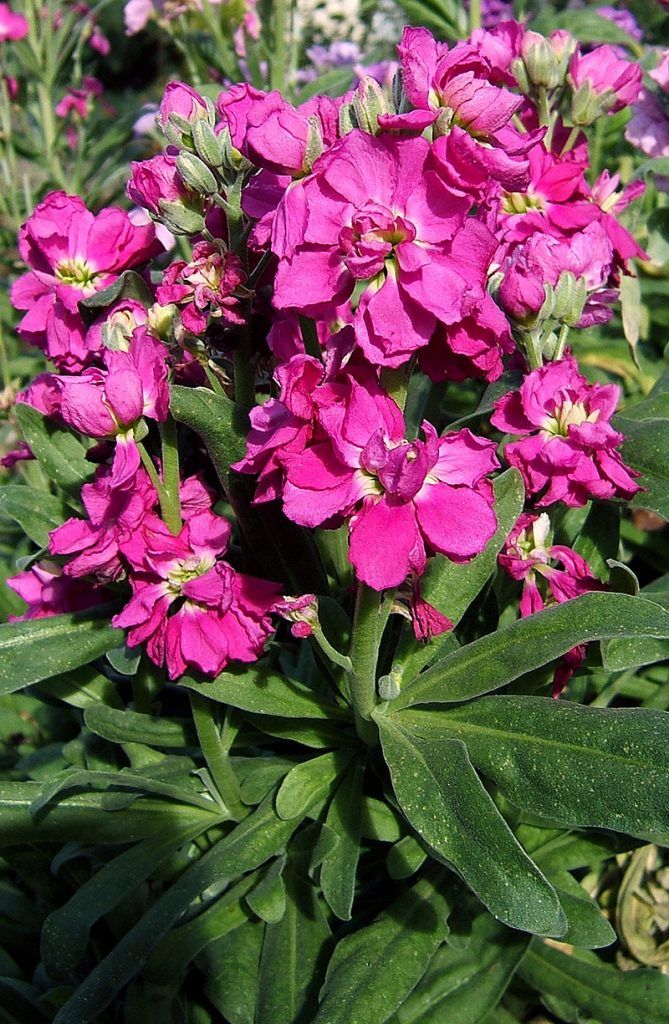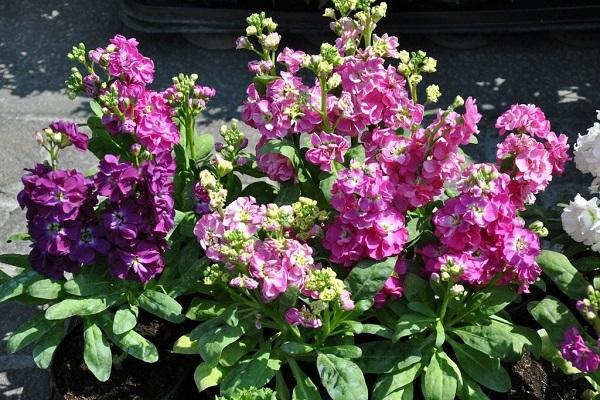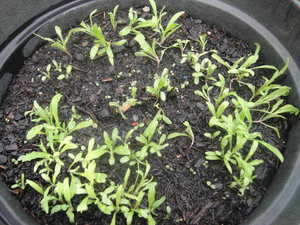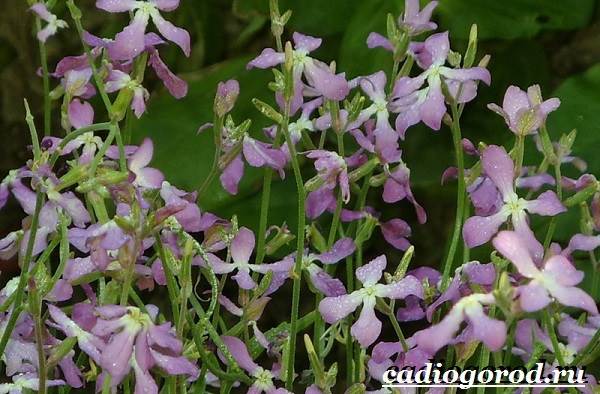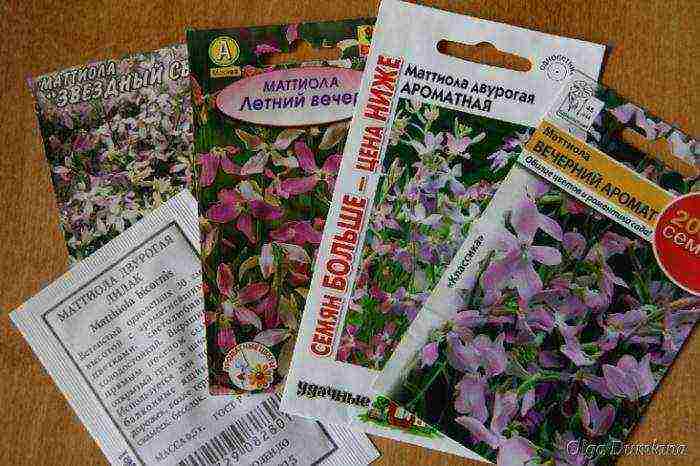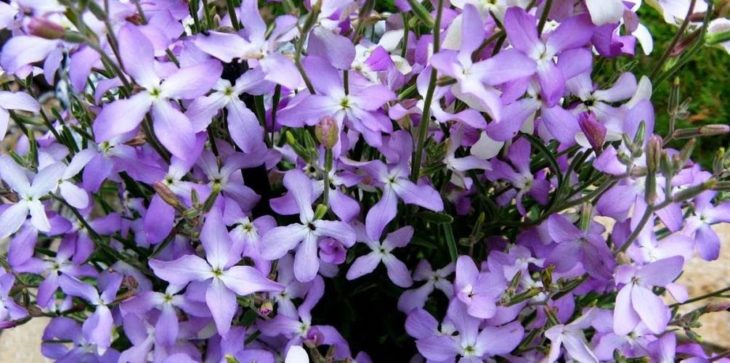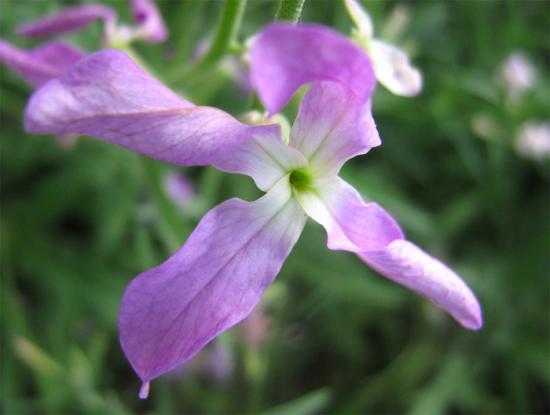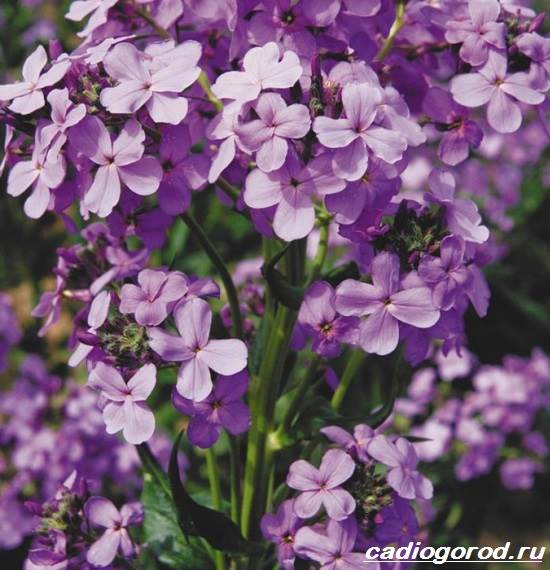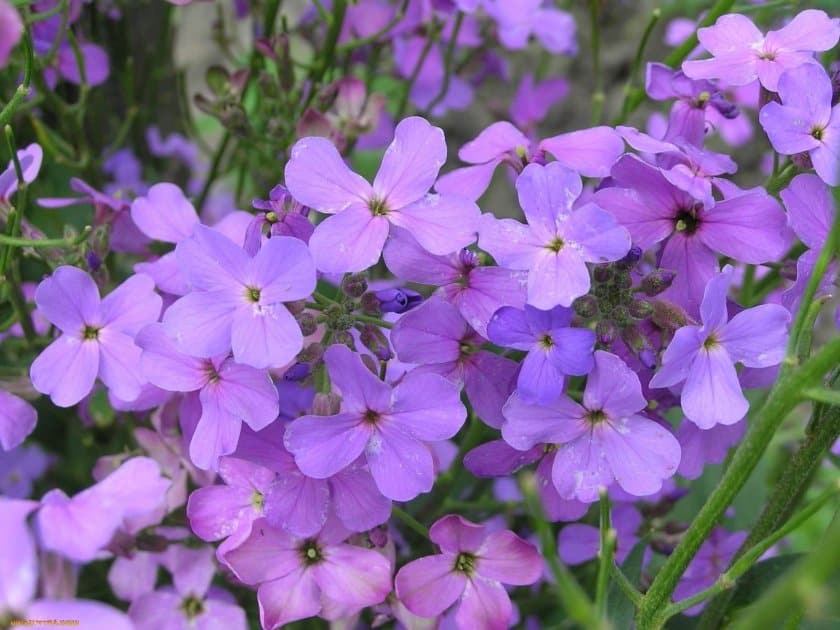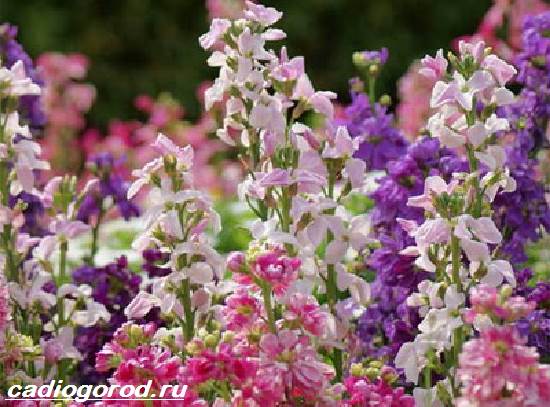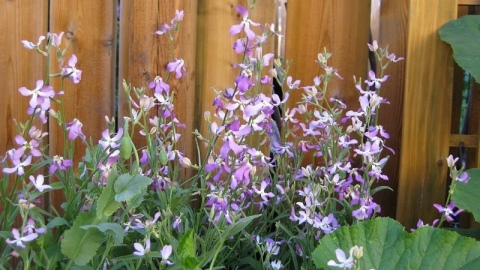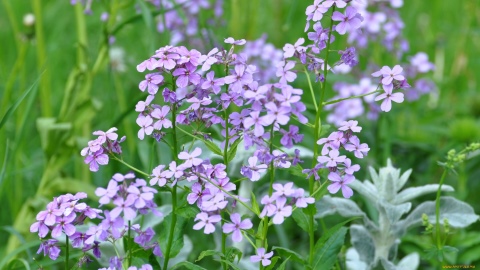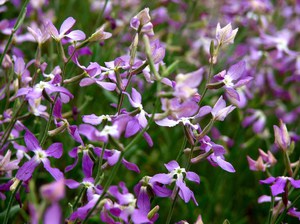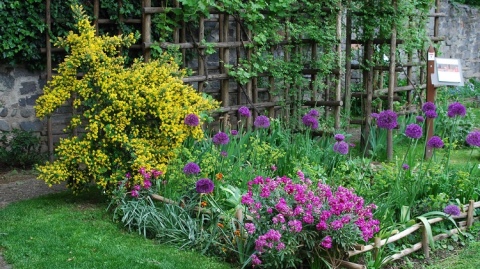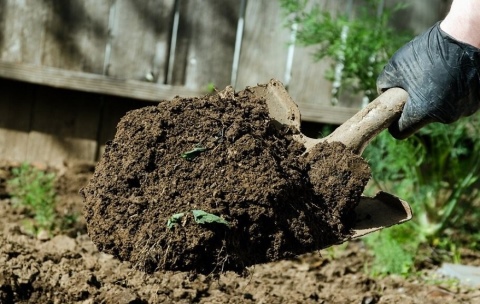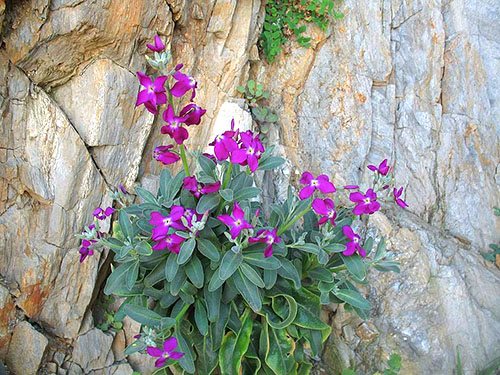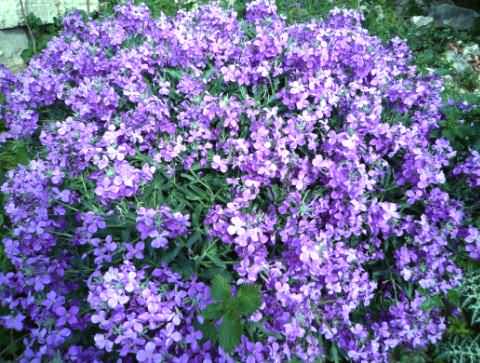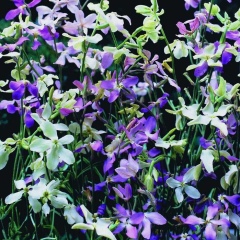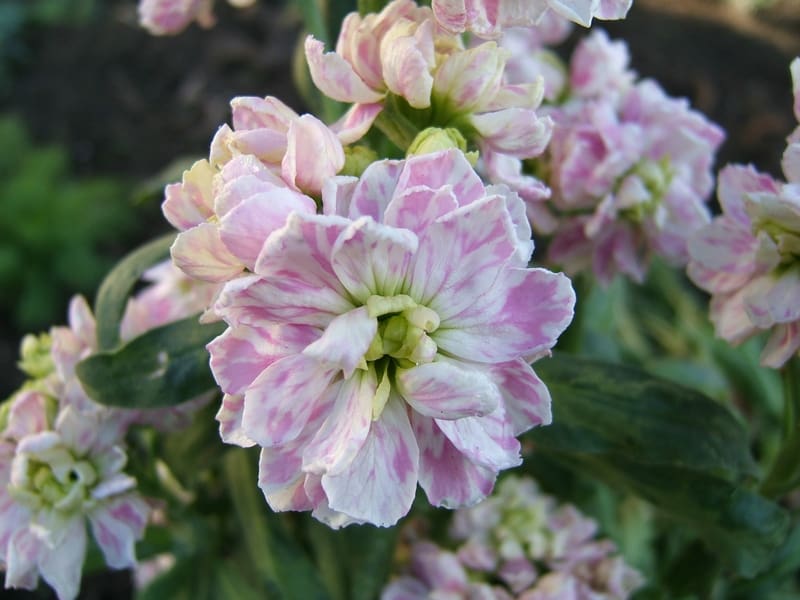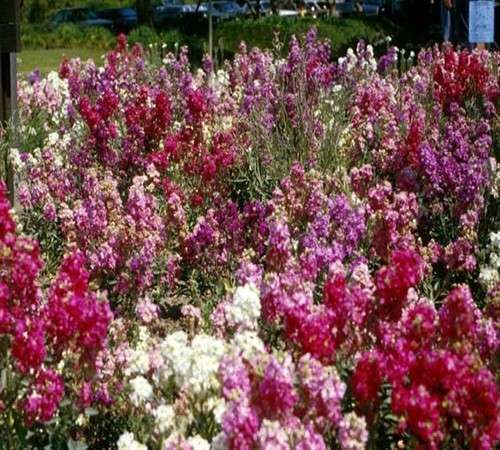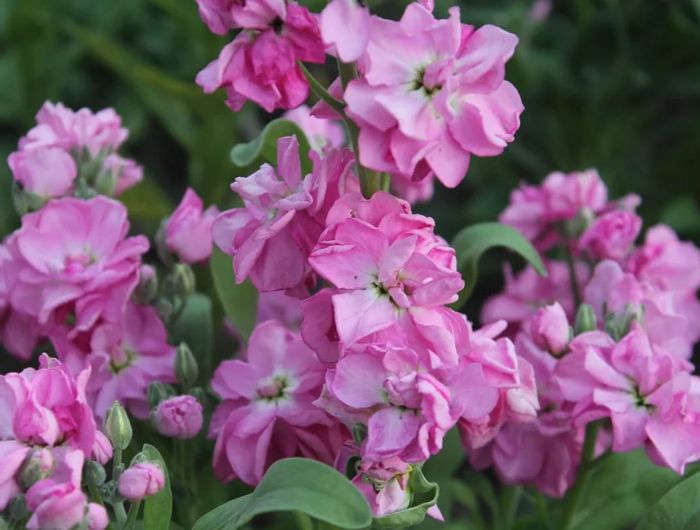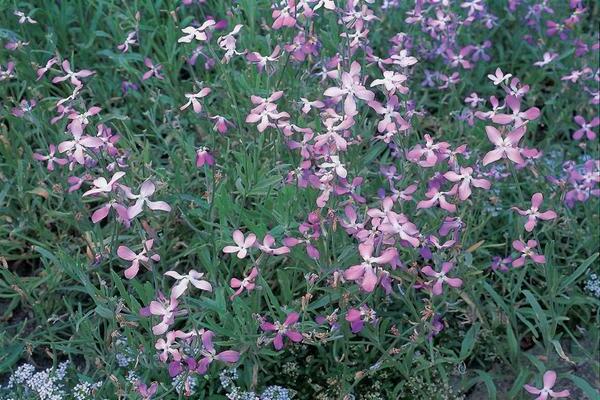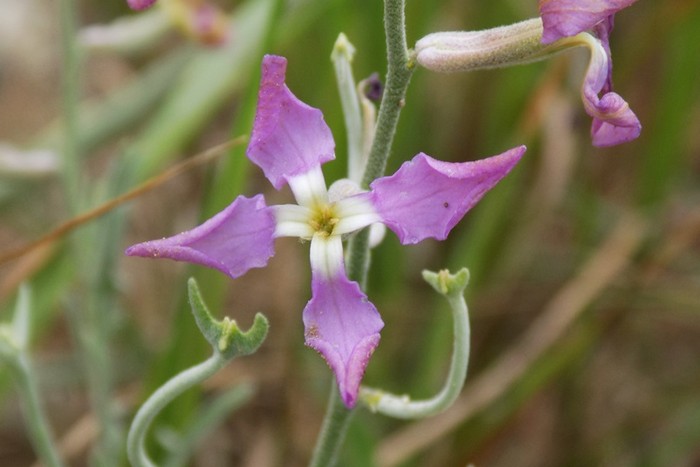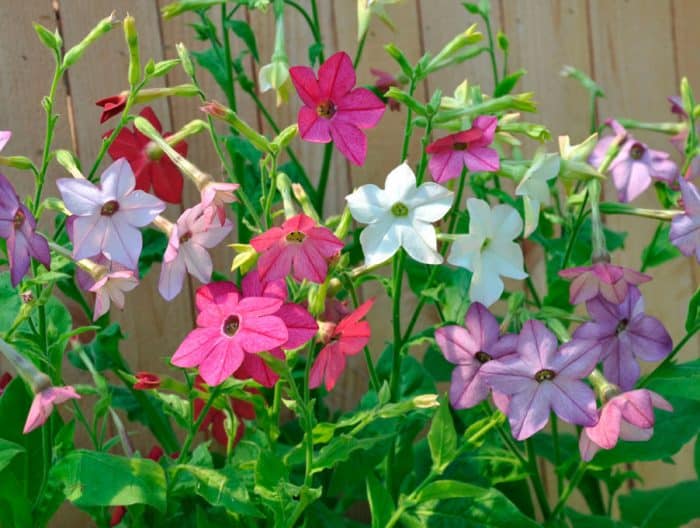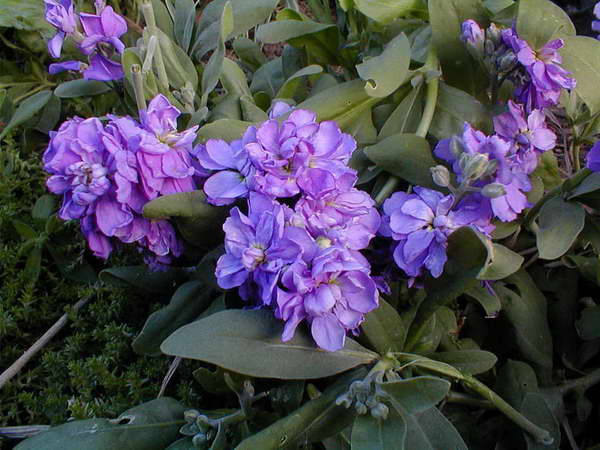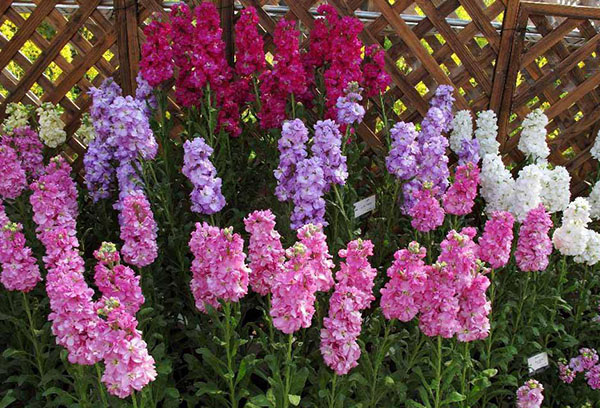How to grow seedlings correctly
Usually the flower is not bred with seedlings, it is better to grow matthiola from seeds. The flower has weak roots, it does not tolerate transplanting well. However, if the gardener wants to get great aromas already at the beginning of summer, then it is better to use a seedling technique.
Planting rules for matthiola:
The seeds are sown in early February. Another sowing is carried out in March, then mattiola will bloom at different times.
Since the seeds are quite small, they are scattered over the prepared soil, keeping a distance of at least 4 cm, and sprinkled with earth a little. You don't need to deepen the seeds
Carefully pour over them with warm water, cover with glass or film.
You need to place containers in the sun. Before the first shoots appear, it is better not to water.
If the seedlings are grown in boxes, then they need to be dived every 2 weeks.
Keep in mind that with all care, some of the seedlings will die.
To minimize the risk of root damage, the soil must be well shed before planting.
Each plant is carefully taken out, trying not to injure the delicate roots. In the container where we will transplant the plant, we make a hole, put the seedling and cover it with earth until the cotyledon leaves
So that the seedling can immediately contact the ground, we squeeze the soil around a little. After that, the plant must be watered.
Professional florists who have been growing Matthiola for several years grow seedlings without diving. A box of eggs or chocolates is perfect for this. After filling the cells with soil, plant 2-3 seeds in a separate hole. As the seedlings grow, they leave one sprout, the strongest.
Conditions for sowing seeds directly to the garden:
- The earth is spilled with potassium permanganate, loosened and grooves are formed with a depth of no more than 0.5 cm, otherwise the sprouts may not break through to the surface.
- For even distribution of seeds, they are mixed with sand in equal proportions and scattered into the furrows.
- Fall asleep with earth by 0.5 cm. Do not tamp, you just need to sprinkle the soil with water a little.
Night violet, which is sown in autumn or spring, emerges in late May - early June.
How to choose a landing site
So that the plant grows healthy, does not stretch in height, it is planted in an area where there is enough sunlight. When disembarking, matthiola must be protected from the wind. Observing these conditions, you can be sure that the plant will grow in a short time, give brushes and delight you with a wonderful smell.
If we talk about the land, then it should be loose and fertile. However, it is not recommended to fertilize the plant with manure, since it may contain phytophthora spores. The plant grows well on loamy and sandy loam soil. The acidity of the soil should be neutral.
It is not advised to plant a night violet in a place where representatives of crucifers grew before. This can provoke a plant disease with keel or fungus.
The soil must be prepared in the fall. Digging makes it possible to prevent fungus or black leg. The earth needs to be dug at least 40 centimeters deep. You can dig up while adding manure to the soil.
How to properly care for seedlings
Mattiola two-horned will grow up healthy even among amateurs, if you follow all the rules of planting and caring for her.
- When 2-3 leaves appear on the plant, the plants dive. You need to leave a distance of 15-35 centimeters between the sprouts. It is also necessary to take into account the peculiarity of growth. Tight seating can cause fungal growth.
- Mattiola loves watering, but does not tolerate waterlogging, the rhizomes can rot. Weeds must be removed immediately after emergence.They can weaken plants as well as provoke the appearance of fungus.
- After watering, it is imperative to loosen the ground so that air can penetrate to the roots.
- Faded inflorescences must be removed so that they do not absorb nutrients.
- Matthiola needs to be fed after planting. Usually, nutrient mixtures for indoor flowering plants are used for this. The first time feeding must be done 3 weeks after planting in open ground. It is especially necessary to feed the plant during the period of bud formation and flowering.
Features of the orchis

The orchis plant is also popularly called wild orchid, orchis, or cuckoo tears. This Red Book plant can be a real highlight of any garden plot. During the flowering period, such a culture compares favorably with all other garden plants for its unusual beauty.
If you decide to decorate your garden with a wild orchid, then remember that in no case should you look for a seedling in the wild. The fact is that this endangered plant is under the protection of the state. Even if you unexpectedly come across an orchis in the wild, the only thing you can do is admire its beauty.
But in your garden, you can freely grow orchards. They were bred by breeders for industrial cultivation, as well as for cultivation as an ornamental plant. Of course, it is not easy to buy a seedling or orchis seeds, but it is quite possible. Most often, it is enough to place an order from the catalog. When buying seedlings at the market or from a gardener you know, try to find out where this orchis was grown. The fact is that for participating in the reduction of the population of such a plant in the Red Data Book, you can be punished by law.
The bush reaches a height of about 50 centimeters. The thickened rhizome has an ovoid shape, due to which the plant was called orchis. The bush has many upright shoots that adorn long, lanceolate leaf plates. They taper towards the petiole and seem to "hug" the stem. The foliage shape of orchis and cereals is very similar. However, the wild orchid stands out from many other horticultural crops with its bright green foliage.
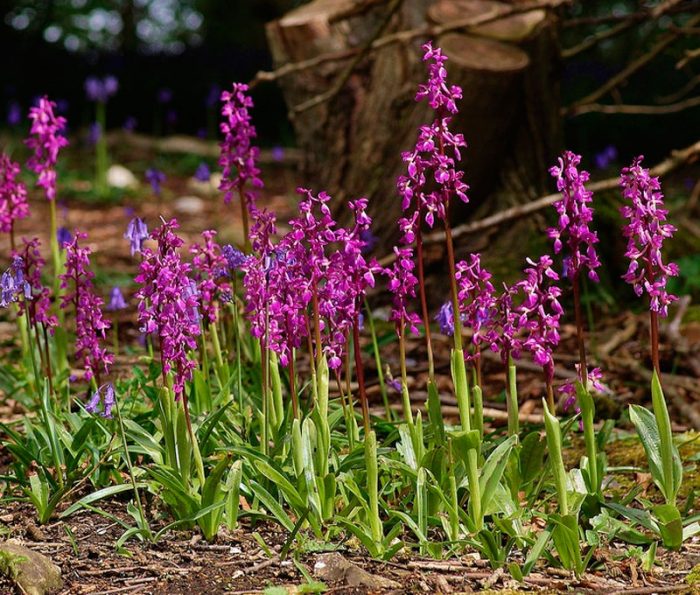
For this plant, the Latin name Orchis comes from the ancient Greek ὄρχις, which means "egg". The fact is that a pair of orchis tubers are very similar to testicles. There are several versions of how exactly the Russian name of this plant came about. In etymological dictionaries, there are at least 3 versions of the origin of the name of the orchis:
- it comes from the dialect word "yatro", which translates as "egg";
- the root of this plant was used to prepare a love potion (yatrov flower);
- VI Dal believed that the name came from the word "kernel", which means "core".
In common people this plant is often called "tears" or "cuckoo tears".
Such a plant is most decorative during the flowering period. At this time, tall peduncles grow, on the tops of which spike-shaped inflorescences are formed, their length varies from 15 to 20 centimeters. In each inflorescence, several complex flowers, distinguished by high decorativeness, sit tightly. Despite the fact that the size of the flowers is only about 20 mm, their beauty is often compared to orchid flowers. The petals of the inner and outer circle are interconnected, forming a kind of "helmet". The flower's lip is tripartite, and the petals located below and above can have different sizes and shapes. Often there are specks on the surface of the lip, and the flower looks incredibly elegant because it has a spur, which is equal in size to the ovary.
The duration of flowering depends on the species of orchis and can last from 15 days to several months. In undersized varieties and species, the beginning flowering occurs in April-May, and in the strong-growing - in June.In most of the species, the inflorescences cannot be called fragrant, however, a subtle pleasant smell of vanilla emanates from them.
Orchis I Benefits and application I This will not tell you at the pharmacy
How to properly care for a plant
The night violet does not look like an expressive and captivating plant at first glance: sloppy, delicate purple flowers paint the flower beds and front gardens in pastel colors, but with the onset of evening, the subtle nectar fragrance of flowers falls in love without hesitation and resistance. The flower has always been a favorite among summer residents, it was planted near the gazebos or not far from the entrance to the house, so that you can feel a pleasant aroma while relaxing in nature in the evening.
We plant in open ground
Seeds are planted when the risk of frost is over - around the beginning of April. And in order for the result to please gardeners, you need to follow simple recommendations:
Location. For a night violet, the optimal planting place will be both an open sunny place and a space shaded by the crown of garden trees. In the latter case, the plant will play an additional role, attracting insects with its aroma in the evening for pollination of garden fruit trees. For long-term cultivation, it is better if the place for the flower bed with the nocturnal is not a lowland and there is no groundwater nearby.
You can plant a night violet:
- Along the house or fence;
- By the terrace;
- Garden fruit trees;
- In flower beds;
- In the form of group landings;
- With companion plants.
The soil. The flower does not like too acidic soil, so it is best to remove the top layer and mix it with ash
It is also important to remember about the nutritional value of the earth by adding peat or humus
Humidity. The amount of moisture does not affect the growth of the plant in any way. The night violet easily tolerates drought, but this, nevertheless, can affect the appearance. It is also necessary to ensure that there is no waterlogging, since the root system may begin to rot.
For continuous flowering, additional sowing of seeds must be carried out every 10 days. Thus, a fragrant, beautiful and picky plant will always grow in your summer cottage.
Watering and feeding
Watering a night violet should be systematic, but discreetly, no more than once every seven days, especially when the summer is dry. It is not necessary to let the earth dry, but the stagnation of moisture is very painful for the plant. It is very beneficial to clear the ground near the plants after watering. It is advisable to water the process in the morning, and in 2 stages, for the sake of good moisture access to the depths of the earth.
The plant should be fed no more than 2 times a month with mineral fertilizers.
Night violet loves humid air very much, but at low humidity it feels great and this in no way affects flowering. It borders efficiently on various plants, although it expands easily.
Night violet feels great, both in well-lit areas and in the shade of huge plantings. Neutral or slightly alkaline fertile areas with excellent drainage are best suited for its cultivation.
When the vigorous development of the flower begins, good watering of the plant is necessary. It blooms poorly and develops in hot weather when there is not enough moisture. For this reason, timely, but not excessive watering becomes the main condition for the normal formation of the night violet.
Temperature regime
Hesperis is a frost-resistant plant that does not require special measures to protect it from low temperatures. It is necessary to build an additional shelter only in winters with little snow, but frosty.
Winter care
- Even if the air in the apartment is dry, the plant should not be flooded;
- Make sure that no burns appear on the leaves due to the effect of "snow and sun". When burns appear on the plant, the plant urgently needs to be removed from the windowsill or from the place where the sunlight reflects from the snow.
- in order to reduce the effect of cold from glass, for the winter period violets can be put in a box with foam.
- In winter, violets should be watered only with warm water.
- Violets do not tolerate drafts, if you ventilate the room, then it is better to take the plants out of the room.
- To increase the humidity in dry apartments, the plant can be placed in a box containing expanded clay and water. When the air is too dry, the leaves of the night violet turn pale green, dry, the shine disappears.
- In winter, there is often insufficient lighting, which can affect the plant and worsen its well-being. It is necessary to arrange artificial lighting for the flower.
Botanical characteristics
Mattiola (Levkoy) is a flowering plant from the Cruciferous family (Cabbage, Brassicaceae). It is a small bush 100 cm high. Straight branches are densely covered with foliage. Below, next to the roots, they harden and stiffen. The plant has long, elongated leaves of a rich green hue. Their edges can be smooth or jagged. Fragrant flowers of unusual shape consist of 4 petals. Their color is incredibly diverse: Levkoy flowers can be white, yellow, red, purple, blue, brown, pink, etc.
Mattiola blooms profusely. Different types and varieties of levkoy are both annual and perennial. The most common annuals are all varieties of summer levkoy. Perennial mattiola is represented by many different types: fragrant, winter, gray-haired, etc.
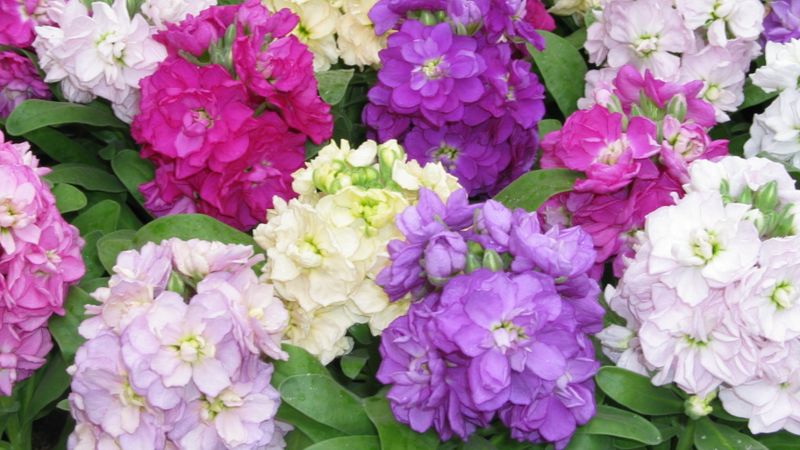
Levkoy, mattiola, night violet
The word "levkoy" in translation from ancient Greek means "white violet". This flower received its scientific name in honor of the Italian doctor and botanist Pietro Mattioli. The plant is also called "night violet".

Fragrant levkoy
Meet the queen of the night
The progenitors of matthiola grow on the territory of Greece and Asia Minor; mentions of this plant are known already in the 16th century. This annual is distinguished by its eccentricity, in the daytime the flowers are covered, but with the onset of the evening they open and begin to exude a pleasant aroma.
The plant, depending on the variety, can be erect or spreading, with proper care it can reach 60 cm in height. The stems and leaves are strongly pubescent, the foliage is bright green, bordered by teeth.
The inflorescences are collected in a brush of rather pale tones, the flowers are small, simple, sometimes double. Flowering begins in July and lasts until the first cold snap. After flowering, pod-like fruits with very small seeds are formed, the germination of which lasts for three years.
In nature, there are over 50 species of matthiola, it is also a fragrant violet, however, flower growers are engaged in breeding only two of them:
Mattiola is two-horned;

Levkoy or gray-haired mattiola.
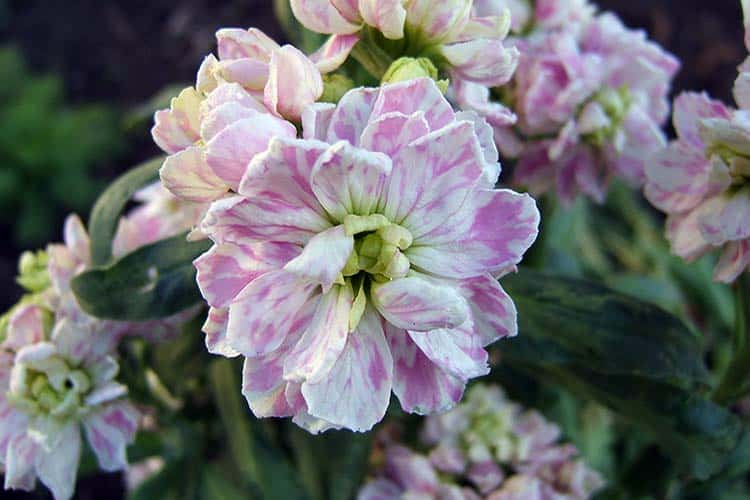
Now breeders have created dozens of various varieties of violets, each of which differs in appearance, color and aroma. Today we will deal with one of the two-horned mattiola varieties, namely the "Evening aroma". This variety is distinguished by abundant branching.
The height of erect shoots reaches half a meter. The flowers are incredibly fragrant, medium-sized, delicate lilac shades.
2 Growing from seeds
At home, you can grow Matthiola two-horned from seeds using the seedling method. Cultivation can be started from late March or early April.
Sowing algorithm:
- 1. Pre-treat the seeds. You need to fill them with water at room temperature for a day. After the enlarged grains, wrap them in wet, rolled gauze several times and leave in a cool room for several days. This is how stratification is carried out. It increases the percentage of seed germination.
- 2. Prepare containers. They should be wide but shallow. It is imperative to make many holes at the bottom to drain excess liquid.
- 3. Pour small stones, pebbles, gravel, expanded clay on the bottom of the container, which will act as drainage.The layer should be about 2-3 cm thick.
- 4. Fill the container with the substrate. It is recommended to mix 3 parts of turf and 1 part of sand, then pour water over it.
- 5. Spread the seed evenly. Press the seeds 5 mm into the ground. Spray with water from a spray bottle.
- 6. Cover the container with plastic wrap and place in a dark, warm place. The temperature should be around + 20 + 22 degrees.
The first shoots will appear in 5 days, but you need to wait about 1.5-2 weeks. After this time, you can remove the film from the container, and rearrange the container in a well-lit place. The room temperature should drop, but be at least +12 degrees. In such conditions, seedlings will begin to develop and grow rapidly. The best option is a bright, unheated veranda.
For the first time, the seedlings are watered 2 days after the sprouts appear. 2 weeks after the emergence of all shoots, it is recommended to pick. Plants are planted in separate small containers with a drainage hole at the bottom. The substrate should consist of 2 parts of sod and leafy soil, 1 part of sand and a small amount of hydrogel. The latter component is optional, but it improves root nutrition and retains moisture in the soil. At this stage, there is still no foliage on the seedlings, this is the norm. Plants of late and medium flowering varieties can be planted in open ground immediately, without intermediate picking.
Seedlings also require hardening. You can take out flower pots to the veranda or balcony, periodically open the window. Each time, the duration of the session must be increased. Shortly before planting plants in the garden, you need to hold them all day near an open window. It is best to start hardening 2 weeks before matthiol is planted in the open ground. This is usually done in the last days of spring. It is recommended to plant in the evening or on a cloudy day, otherwise the sun's rays will damage young plants that have not yet matured.
Areas where plants from the Cabbage family used to grow are not suitable for planting Matthiola bicorn. This is due to the fact that a parasitic insect, a cruciferous flea, remains in such places. The soil for sowing seeds for seedlings from such beds also cannot be dug out: there is a high probability of infection of seedlings with a disease such as black leg, which is provoked by fungal infections.
In the garden, Matthiola two-horned should be planted in an area with drained soil and diffused lighting. Fertile soil of sod-loamy or sod-sandy loam type with a neutral or weak alkaline reaction is optimal. It is necessary to make holes for young plants, moisten the soil in them and carefully place flowers there, straightening the roots. Then the free space of the holes is covered with earth and moistened.
Which variety of levkoy to choose for planting
It is not necessary to know all the nuances of the classification
When choosing seeds, you must carefully read the description of the variety, paying attention to the following parameters:
- plant height;
- the size and shape of the inflorescence;
- flower size;
- flowering time;
- shelf life.
Popular varieties with photos
Mammut Excelsior variety (Mammut is the most excellent).
It belongs to the group of single-stemmed varieties, usually reaches a height of 70-80 cm, forms a long dense inflorescence on a powerful stem, consisting of double flowers up to 5 cm in diameter. It has many shades: red, yellow, white, apricot. Good for cutting. Tall varieties: Fox (pink), Step (red), Excelsior (different shades), Miracle.
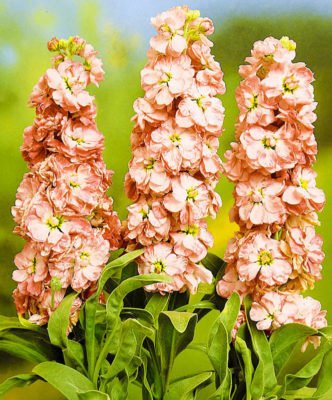
Variety Thumbelina.
Refers to dwarf varieties. Plant height is not more than 30 cm. Dense pyramidal inflorescences consist of large double flowers. Shades from white to dark purple. Beautiful in a flower bed, due to its compactness, it feels great in pots.Dwarf varieties: Gnome (different colors), Sun bunny (yellow), Lapis lazuli (blue), Ten Vic (different colors), Intuition (20 cm high).

Thumbelina, mix of shades
Variety Ten Vic.
Has lush inflorescences of densely double flowers. Height - 30 cm.
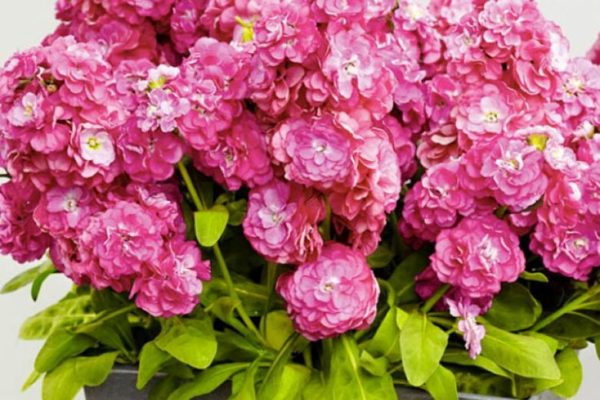
Ten Vic pink
Snowflake variety.
It has racemose inflorescences and large snow-white flowers. Its height is no more than 25 cm.

Shrub varieties (different shades).
The bush form of a flower bush is suitable for flower beds. Plants are highly branched, inflorescences are loose, flowers are very large (up to 5 cm). It looks like a blooming cloud.
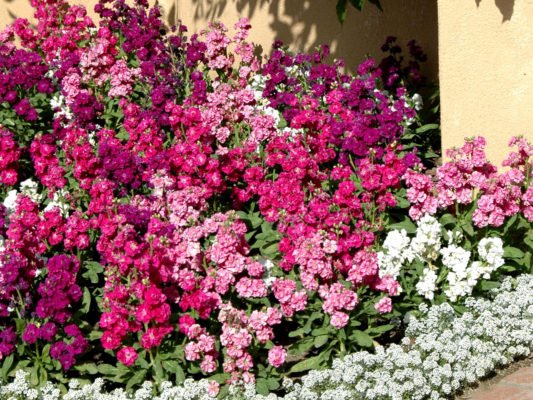
Shrub, mix of shades
Varieties Bouquet and Victoria.
They form a group of bouquet levkoi, which are characterized by an equal-level arrangement of the main inflorescence and lateral ones.
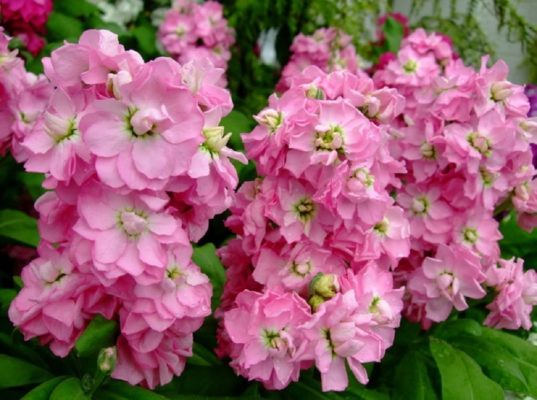
Levkoy gray-haired.
Garden group of varieties with a height of about 60 cm, pyramidal inflorescences, various shades. Varieties: Gray-haired giant.
Grizzled giant purple
Variety Aida.
It has a bush height of about 50 cm, large double flowers of delicate colors, collected in racemose inflorescences. They form very beautiful borders.
Related article: What are the features of planting large trees in the country
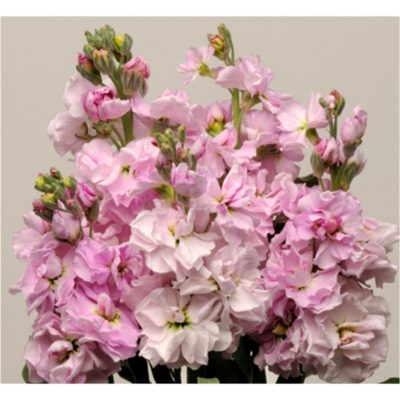
A close relative of Levkoy is Mattiola Bicornus, also known as Night Violet. This flower is invisible during the day, but at dusk, like little stars, they open up and exude a wonderful aroma. Since mattiola is much closer to the wild, it is much more resilient. It can be sown directly into the ground in early spring and even before winter near those places where people spend time in the evening.
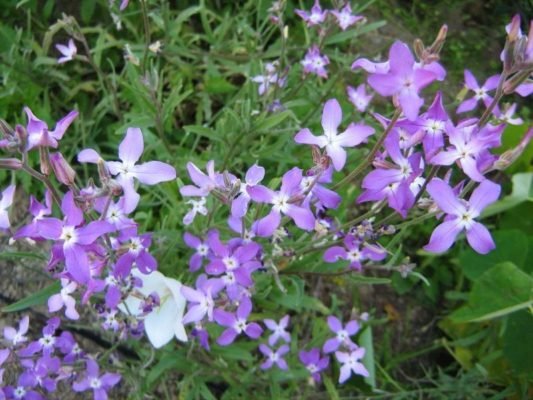
Mattiola - landing, 4 ways
It is important to note that matthiola can be grown both through seedlings and through immediately sowing in open ground. But not all types of levkoy can be grown through seedlings, just as not all can be grown without seedlings.
Sowing matthiola seeds
Mattiola planting and care begins with sowing seeds, so further we will consider growing matthiola from seeds
... Most often, matthiola is grown as an annual plant, so the seeds are sown in March-April,
but it can also be grown as a biennial plant. In this case, the seeds are sown in July-August. Since the seeds are small, they are planted shallow - 2-3 cm will be enough. A characteristic feature of matthiola planting and care is that in the ground no organic fertilizers should be added before sowing seeds.
Also, do not sow Matthiola in areas where cruciferous plants previously grew. Due to its unpretentiousness, this flower can be sown in almost any area. It grows best in the sun, but it also tolerates partial shade well.

When growing matthiola from seeds, the containers must be kept in a warm and dark place until the first shoots appear. When the seedlings hatch, the boxes with seeds are taken out into a room with a temperature of 8-12 degrees, but always light
.
The emergence of seedlings means that the seedlings can be transferred to a bright room with good ventilation and a temperature of 8-10 ° C. Now they can be watered a little in the morning so that the soil surface has time to dry out and ventilate.

At the age of 2 weeks, the seedlings dive into deeper boxes filled with a mixture of the following composition: sod soil, leafy earth, sand. As soon as it gets warmer outside, boxes with seedlings are taken out to greenhouses. To get levkoi flowering in waves, the seeds are sown every 2 weeks.
In order for levkoy to bloom all summer, it should be sown every 3 weeks, starting at the end of winter.
Planting matthiola in open ground
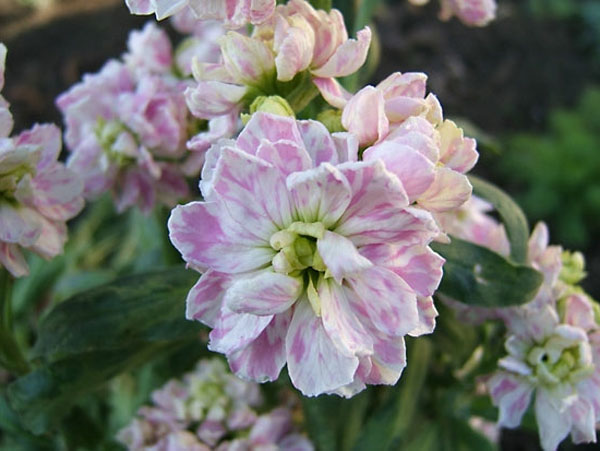
Matthiola grown from seeds is planted in open ground with the establishment of warm weather. Here you need to take into account some nuances: organic matter cannot be introduced at the site of planting of levkoy, and it is also not recommended to plant seedlings in the place where plants of the cruciferous family grew a year earlier. Mattiola seedlings are planted in individual shallow holes or shallow trenches are made for planting.The depth and width of the hole should correspond to the size of the root system of mattiola seedlings.
Shrub varieties of Matiolla are planted with a distance of 20-25 cm between plants, a horned night violet is planted in open ground more densely - 10 cm between seedlings.
If it is necessary to plant a high matthiola, the distance is increased to 40 cm, which is due to the diameter of the future plant. Depending on the type of matthiola purchased, seed cultivation should be carried out taking into account the biological flowering period. If the planting of seedlings is thickened, the likelihood of matthiola being affected by fungal diseases increases, which destroy all plants, including basil.
Matthiola is best planted on a cloudy day or in the evening after sunset.
Plantings are watered and mulched with dry material. Matured compost is only suitable as mulch if mattiola seedlings are planted in poor soil.
The second common name is levkoy
So, you ask: why did you add photos of such scary cats to this article. Well, firstly, there are no comrades in taste and color, as they say ... And secondly, this breed of cats is called Levkoy, but let's not talk about sad things)) To the right of the photo of cats is a beautiful flower-teska.


Use in landscape design
The night violet is an unusual plant that has an ordinary appearance and a stunning aroma. These features must be taken into account when choosing a place for planting matthiola. Landscaping experts recommend planting a night violet near the house, next to summer gazebos, playgrounds, as well as along the edges of paths. For the aromatization of the entire local area, it is not necessary to make huge flower beds and flower beds; it will be quite enough to plant small groups of plants throughout the site.
In order for the green spaces of night violets to attract attention not only in the evening and at night, they must be combined with other flowering plants that will delight the eye during the day.
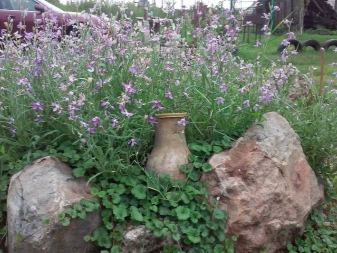

The flower looks harmoniously with thyme, basil, sage, verbena, petunia, nasturtium, balsam, lemon balm and mint. Geranium, monarda, yarrow, daisy will help revive the green spaces of night violets. Combining a flower with a tea rose will result in a round-the-clock scent.
Many gardeners use the night violet not only for landscaping the site, but also for decorating balconies and loggias. In comfortable growing conditions, this flower feels good in flower pots and decorative vases. In order to enjoy the enchanting aroma of mattiola not only outdoors, but also indoors, it can be used in bouquets and flower arrangements. Plants, uprooted with roots, can be fragrant for several days.
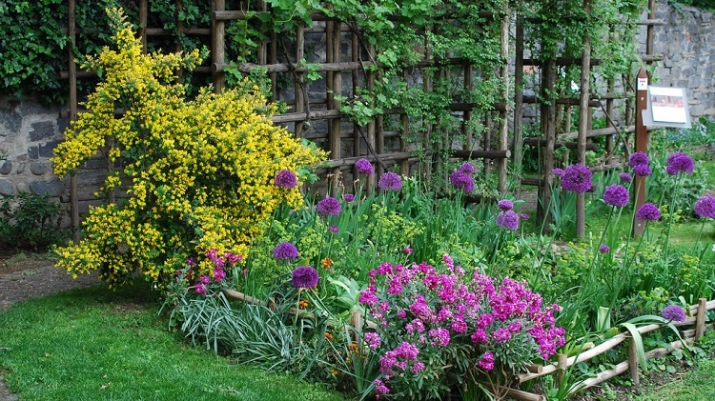
In the next video, you will see the sowing of matthiola bicorn in open ground.







